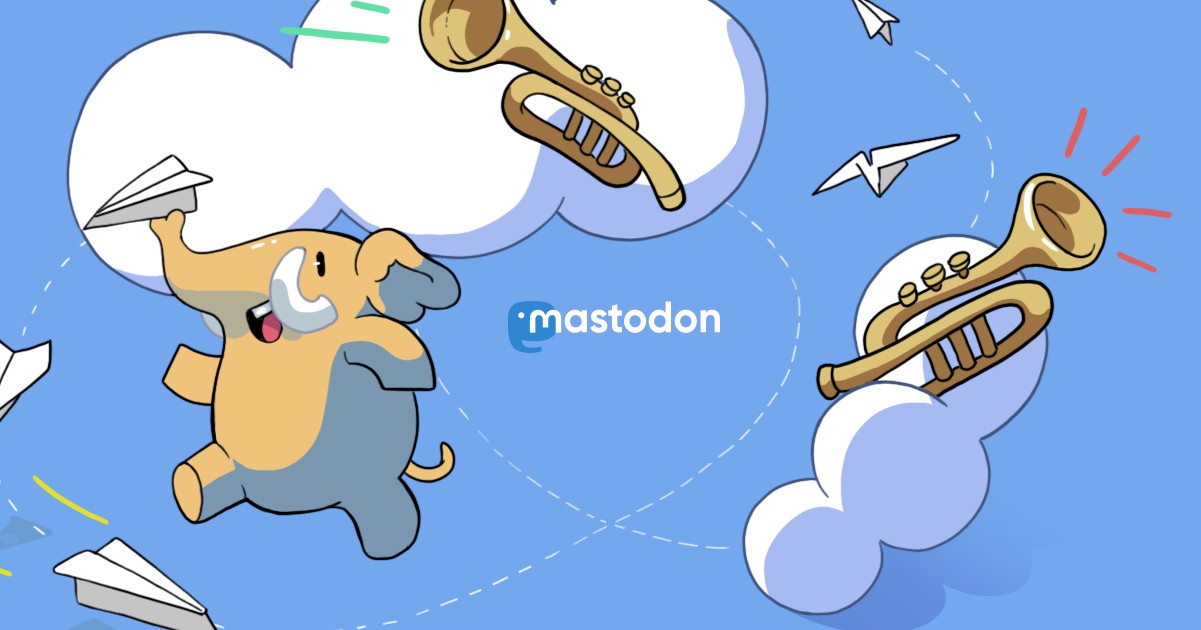yet another explanation of Mastodon
The situation: you’ve seen people talking about Mastodon. Maybe you’re intrigued, maybe you’re not. Either way, when they’ve tried to explain it to you, you’ve been confused, turned off, or maybe even a little angry that they won’t shut up about it.
I’m going to try and undo some of that damage. This post is intended to start out with a non-technical general explanation and go from there to explain Mastodon in more and more detail. Don’t feel obligated to read farther than you’re interested to learn. That being said, I’ve tried to keep from getting too far into the technical side (that’ll come in a different post), so I think that it should be readable to anybody who’s interested.
basics of Mastodon
Mastodon is a microblogging1 service, similar in some ways to Twitter, but with some key differences: 1. it has a 500-character limit 2. it’s not controlled by a for-profit company 3. anybody can run their own version of it, and still talk to everyone else
Point 3 gets at the bit that people tend to find confusing. Some simple comparisons that we can draw are email and telephones: your email might be from Apple, your employer, Protonmail or somebody else, and your telephone might be managed by O2, T-Mobile, or somebody else. Behind the scenes, those services all federate with2 each other. Email does by looking up the email domain3 and then having that email service route4 from there to the addressee5. I don’t know how telephones do it.
Mastodon also federates. Imagine if I could run a Twitter account on my own domain6, example.com — I would then be known as @rowan@example.com, and you could follow me from your account on twitter.com.
So now, we’re starting to envision a democratic system. Everybody has a choice about where to put their social presence, and can still follow their friends no matter where they are — same as you can visit any website from any internet service provider, web browser, location.7
Mastodon takes this utopian internet vision and puts it into practice. From my account on toot.cafe I can follow my friend @ebeth on witches.town, or @shel on cybre.space, or anybody else using Mastodon.
communities
This leads into the next thing that makes Mastodon special: because anybody can create an instance8, and any user on that instance can follow anyone using Mastodon, you can have interest-specific Mastodon websites. To give a taste: * toot.cafe: directed at web developers * mastodon.art: as the name implies, a hub for artists. a few months ago there was a mass influx of comics people; a lot of them ended up here * social.coop: run as a platform cooperative. This is a great place for people who like to geek out about coops * and thousands more! instances.social and joinmastodon.org exist to help you find what you’re looking for.
Details of communities on Mastodon — and what they mean to me — are outside the scope of this post. If you’re interested in learning about instances, why they build communities, and the ones that I’m on, check out my blog post why I join Mastodon.
step back: it’s the fediverse
Except, wait! Mastodon doesn’t only talk to Mastodon. The federated social web9 has existed for years, with geeky things like diaspora* and identi.ca — not standard household names, by any means. Mastodon is special in that it helped bring the fediverse10 out of the shadows, and fostered a community that is excited about openness11 and sharing the fediverse with everyone, not just an artificially elevated “tech elite”.
Since Mastodon started, there has been an explosion of excitement about the fediverse. @puckipedia is writing Kroeg, a group of people headed by @BanjoFox are working on Aardwolf (modeled off of a federated facebook), and even I am working on pylodon and its companion smilodon, and there are many more federated projects. Each of these will be able to federate with each other, contributing to a vision of a future where you can not only follow somebody on (heavy implicit metaphors ahead) Twitter from Twitter, but also from Facebook.
The fediverse imagines a future where there are no walls between social networks, blogs, and whatever springs up — you choose the one(s) that work(s) best for you, and just follow your friends. No thought required.
This post is also published on Medium; if you enjoyed it, please consider clapping.
- blogging with a limited character number, to keep it short [return]
- talk to [return]
- e.g. protonmail.com, the bit after the @ symbol [return]
- send to the right place [return]
- the bit before the @ symbol [return]
- internet address, or url [return]
- unless your government blocks them [return]
- a website that is Mastodon [return]
- Mastodon is a part of this federation, as is any social website that federates with other social websites [return]
- see recent hashtag #GetOnMyLawn [return]
